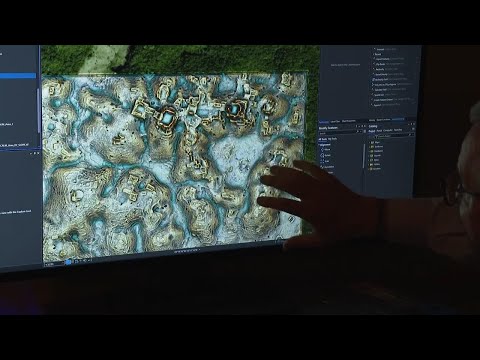(29 Oct 2024)
RESTRICTION SUMMARY:
ASSOCIATED PRESS
New Orleans – 29 October 2024
1. Various of Professor Marcello Canuto working in his office
2. SOUNDBITE (English) Marcello Canuto, Director of Middle American Research Institute, Tulane University:
"And so one of the things we reported in our paper was that in these blocks, these different areas that had been investigated, we found like 6,700 structures."
3. Close up of Marcello Canuto typing
4. Wide of Canuto LiDAR map
5. SOUNDBITE (English) Marcello Canuto, Director of Middle American Research Institute, Tulane University:
"The data that we look in, in these blocks of survey information is remnants of human activity on the landscape. That is buildings that humans built, canals, roads, anything that is not a natural feature."
6. Mid of LiDAR Map
7. SOUNDBITE (English) Marcello Canuto, Director of Middle American Research Institute, Tulane University:
"We’re finding LiDAR is helping us with this technology that’s able to penetrate forest canopy and see what’s on the ground below. We’re able to see in places like Southeast Asia, the Amazon and Maya region that these tropical environments had these really complex and relatively large populations living in these regions for long periods of time."
8. Various of LiDAR map
9. SOUNDBITE (English) Marcello Canuto, Director of Middle American Research Institute, Tulane University:
"The suggestion from these data would be that were we to expand the survey of this particular region or all other regions we would find more of what we found."
10. Various of LiDAR map
11. SOUNDBITE (English) Marcello Canuto, Director of Middle American Research Institute, Tulane University:
"It allows us to tell better stories of the ancient Maya people. We have always been able to talk about the ancient Maya especially in the lowland regions because of their hieroglyphic texts, because they left us such interesting record of their political history and of their sort of sacred or religious history right, so we’ve always been able to understand or at least we’ve always been able to talk about their rulers and in some ways their political history. What we are now able to do is match that information with their settlement and the population and what they were fighting over, what they were ruling over, what they were trading with right and who was involved with this. And that’s really interesting because it marries the political and the religious parts of the society with the economic, social and demographic parts because these two now are rich datasets that kind of can talk to one another."
12. Various of Middle American Research Institute gallery
13. Various of plastered monument replica
STORYLINE:
New research published by Tulane University doctoral student Luke Auld-Thomas and his advisor, Professor Marcello Canuto shows more than 6,500 structures found in a jungle near Campeche, Mexico, including an unknown city.
The structures date back to nearly 1,500 years ago.
The recent findings came with the help of a technology called Light Detection and Ranging (LiDAR) which allows researchers to look through tree canopy and interpret what is on the ground beneath.
"Everywhere where we’re doing LiDAR we’re finding more than what we expected" said Tulane University Professor Marcello Canuto.
Tulane University’s Middle American Research Institute (MARI), which studies indigenous Central America, has been using LiDAR technology for nearly a decade and has built an advanced laboratory to analyze LiDAR data.
===========================================================
Find out more about AP Archive: http://www.aparchive.com/HowWeWork
Twitter: https://twitter.com/AP_Archive
Facebook: https://www.facebook.com/APArchives
Instagram: https://www.instagram.com/APNews/
You can license this story through AP Archive: http://www.aparchive.com/metadata/youtube/5e5d2455f2e848b2a0091b3e3350b08c
Author: AP Archive
Go to Source
News post in November 4, 2024, 12:05 am.
Visit Our Sponsor’s:
News Post In – News





